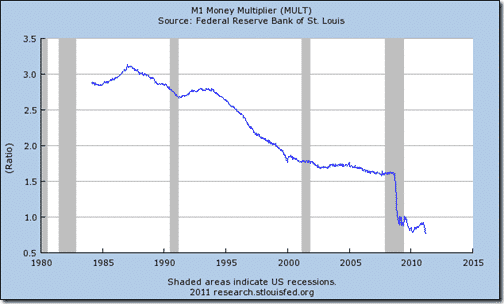Chart of the Day: M1 Money Multiplier
M1 is the narrowest definition of money. It includes currency and coins, traveller’s checks, and checking accounts (so-called demand deposits). The chart below from the St. Louis Fed shows the relationship between base money that the Fed controls and M1 (hat tip Dan).
Since the bull market in equities and fixed income began in the early 1980s, the M1 money multiplier has steadily declined for a number of reasons. But when the Lehman panic came, the multiplier plummeted as the Fed expanded its balance sheet. Traditionally, economics students are taught that injecting base money into the system and allowing reserves to build up as the Fed has done is inflationary because it increases money and credit. However, what is clear from this chart is that there is not a very good correlation between base money and M1. To date, post QE-inflation has been acute not in credit and consumer prices, but in prices of assets like junk bonds, pre-IPO social media companies and commodities.

Absurd. “Money banking textbooks written before 2008 are “now obsolete”, as the Fed now has the ability to pay interest on excess reserves, he said in response to an audience question” — DUDLEY
“There is general agreement that, for almost all banks throughout the world, statutory reserve requirements are not binding. Banks need central bank deposits for clearing checks and making other interbank payments, which gives the central bank leverage over money and bond markets” 2006, the world’s leading authority on bank reserves & the monetary base.
Absurd. “Money banking textbooks written before 2008 are “now obsolete”, as the Fed now has the ability to pay interest on excess reserves, he said in response to an audience question” — DUDLEY
“There is general agreement that, for almost all banks throughout the world, statutory reserve requirements are not binding. Banks need central bank deposits for clearing checks and making other interbank payments, which gives the central bank leverage over money and bond markets” 2006, the world’s leading authority on bank reserves & the monetary base.
Milton Friedman’s monetary base is not now, nor has ever been, a base for the expansion of new money & credit. Take currency, which comprised 92% of the base on Aug 2008, & subsequently fell to 43% of the base at present. An increase in the currency component of the base is contractionary – unless offset by open market operations of the buying type. I.e., the currency component has no expansion coefficient (because fractional reserve banking is based on the velocity of deposits, not the volume of deposits.
Second, with IORs (54% of the base), inter-bank demand deposits (IBDDs) held at the District Reserve banks (owned by the member banks), have been transformed from cash assets, to highly liquid, bank earning assets.
I.e., IORs have become the FUNCTIONAL EQUIVALENT of required reserves,
Milton Friedman’s monetary base is not now, nor has ever been, a base for the expansion of new money & credit. Take currency, which comprised 92% of the base on Aug 2008, & subsequently fell to 43% of the base at present. An increase in the currency component of the base is contractionary – unless offset by open market operations of the buying type. I.e., the currency component has no expansion coefficient (because fractional reserve banking is based on the velocity of deposits, not the volume of deposits.
Second, with IORs (54% of the base), inter-bank demand deposits (IBDDs) held at the District Reserve banks (owned by the member banks), have been transformed from cash assets, to highly liquid, bank earning assets.
I.e., IORs have become the FUNCTIONAL EQUIVALENT of required reserves,